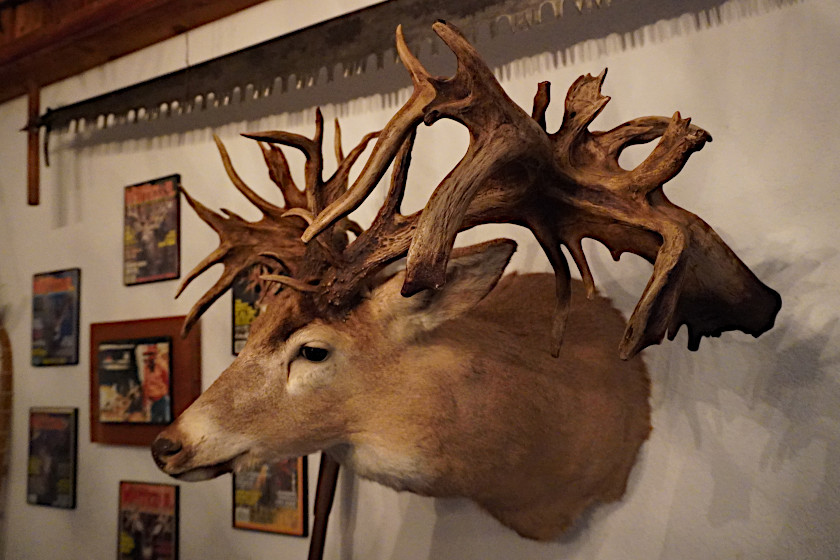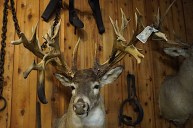In the modern era of deer hunting, sportsmen and women have become incredibly distrusting. Every time a giant non-typical deer is shot, we see the usual claims: "high fence deer," "genetically modified," or "unnatural." It's a sad reality, but modern deer hunters have been pre-programmed to automatically feel suspicious of every big buck that shows up. However, there are a few famous whitetails in the big-game record books that predate high fences and genetic manipulation. These animals prove whitetail bucks are capable of some incredible things in extraordinary circumstances.
One of those legendary whitetails is the famous "Hole-in-the-Horn" buck found in 1940 just outside of Akron, Ohio, in Portage County. This giant non-typical whitetail is one of the largest to ever walk the Earth, and its story is still surrounded by a number of mysteries.
The actual location was just outside the fence of Ravenna Arsenal, where nearly 14,000 people worked to produce munitions during World War II. Today, this military base is known as Camp James A. Garfield and serves as a training camp for the Ohio National Guard.
Ironically, the Buckeye State was not exactly the deer haven it is known as today back in the 1940s. Wildlife management wasn't exactly a priority for the area's first settlers in the late 1700s to the late 1800s. A booming fur trade and a need for venison led to the death of thousands of deer. By the early 1900s, whitetails had been completely wiped out in Ohio, but that fortunately did lead to the cessation of hunting seasons and the start of programs to reintroduce animals to the wild. The deer population in Ohio was still extremely low, however, which kept Ohio from having an established season for another three years, and makes the story of this particular buck that much more interesting.
Who found the Hole in the Horn buck?

Travis Smola
Details on the Hole in the Horn's discovery are a bit muddled. What we know is cobbled together from eyewitness accounts, and even then, details seem to change from source to source. Even the year may be in question, as in a 1991 interview with The Oklahoman, eyewitness Jerry Henceroth recalled seeing the buck shortly after it was found. He claimed World War II was still in progress, making the year 1943, not 1940. Whatever the year of discovery may have been, we do not know the names of all the people who found the deer, only that it was a group of railroad workers. One of the few named eyewitnesses was a man named George Winter, who told North American Whitetail magazine in 1995 that he was there when the Hole in the Horn was found, and adding that it was at least partially tangled up in a chainlink fence.
According to Legendary Whitetails, the buck may have been recovered after an engineer spotted it from a passing train. We do not know what killed this legendary buck, but the prevailing theory says it was struck by a train because of the proximity to the railroad tracks. We may never know for sure, though, as the buck was allegedly heavily decomposed by the time of recovery—the workers only recovered the antlers and the rest was history.
The buck sits in obscurity for 40 years

Travis Smola
Shortly after its discovery, the massive antlers came into the possession of a man named Charlie Flowers, an engineer with Erie Railroad Company. According to Legendary Whitetails, how he came to own the antlers still remains unknown, but Flowers sold the rack to the Kent Canadian Club, a bar in Kent, Ohio, which is still open and running to this day. It may be hard to fathom today, but the selling price was only $25.
In any case, the buck was mounted by a taxidermist and then spent almost 40 years hanging over the bar. Only local hunters even knew of the deer's existence, keeping it in relative obscurity until 1977 when antler collector Larry Huffman first saw a photo of the Hole in the Horn. Four years later, another antler collector, Fred Goodwin, showed him the photo again with a lead on the deer's location. In 1983, Huffman visited the Kent Canadian Club to see the deer for himself.
In the early 80s, interest in big antlers and the record books was just starting to take off. Huffman recognized the rack's significance and quickly acquired the deer as part of the "Legendary Whitetails" collection. It was the perfect time for the antlers to change hands, as the Club had recently started to recognize this was a special animal that deserved more public recognition. It didn't take long for news to spread that this deer could potentially rival the new-world-record "Missouri Monarch" buck, which had been found just two years earlier outside of St. Louis.
Scoring controversy

Travis Smola
Huffman's initial measurements of the Hole in the Horn revealed the buck would likely score somewhere between 330 and 350 inches, with nearly 200 inches of that score coming from the rack's many abnormal points. Boone & Crockett scorer Phil Wright was he first to officially measure the buck in August of 1983, giving it an initial scoring of 342 3/8, which blew the Monarch's 333 7/8-inch score out of the water.
However, Boone and Crockett Club requires a panel scoring verification session with top officials for all world-record entrants. By the end, they came up with a net score of 328 2/8 inches, which put it just below the Monarch in the No. 2 all-time position. Ironically, the Monarch's initial scoring session showed a score of 325 3/8 points before it gained more in a panel scoring session.
To this day, some hunters still believe the Hole in the Horn is the larger of the two deer. There is no questioning the mass of the Hole in the Horn is far more impressive than the Monarch; seldom does a deer carry that kind of mass all the way up the main beams and through all its tines.
Additionally, this is a deer that could probably be measured a dozen different times and you could come up with a dozen different scores. Interpreting B&C's rules gets extremely difficult when a buck is this wildly non-typical and has so many points. As Huffman notes, every scorer is going to have a different opinion of how to score a deer like this. We may never know which one is truly the bigger of the two.
What Caused That Hole Anyway?

Travis Smola
Perhaps the bigger controversy over this deer is the buck's namesake. There is a small hole in one of the club-like drop tines of the right antler that has confounded hunters for decades now. There are three theories to how the deer got this hole, and at least two of them have conflicting eyewitness accounts as to what caused it.
The first theory, and by far the most popular, is that the hole was caused by a bullet from a gun. Many have speculated over the years the hole is the right size and consistency for a .22 Long Rifle bullet. Perhaps an opportunistic farmer, squirrel, or rabbit hunter could not help themselves upon seeing the giant and took a pot shot even though deer weren't legal game at the time in Ohio? This theory stirs the imagination a bit as it makes us wonder if perhaps the second-greatest whitetail of all time was poached.
The second theory comes from Winter, who claimed he knew the secret of the hole in his interview with Huffman back in the early 90s. Winter said one of the wires from the fence was sticking through the antler at the time of the discovery. From there, hunters theorized the buck's thrashing may have caused the wire to slowly bore the hole as the deer died.
"I guess for years everyone has been wondering what made that hole," Winter told Huffman. "But it was definitely caused by that wire."
That may have been the end of it. Except in December of 2015, an entirely new theory emerged. North American Whitetail's Gordon Whittington was in Ohio filming an episode about the deer when he was introduced to Stub Bower, a long-time member, and former bartender of the club. According to Bower, the hole's appearance in the rack comes from the fact the buck is a little heavier on his right side than his left.
Bower claimed the head hung on some lattice in the bar, and it always leaned to the right. Bower said he and the club's manager Whit Nighman decided one day to fix the mounted head so it stood upright. They did this by drilling a hole through the droptine and running a wire through it. They then ran the wire back into the lattice and cinched it tight to keep the buck upright. This explanation may not be as fun as the others, but we must admit, it does make a lot of sense.
So, we have three theories, and two of them have a witness. Make of it what you will, as it's anyone's guess who is telling the truth. Perhaps it's more fitting we will never know for certain what made the hole. It just adds to the uniqueness of this legendary deer. One thing is for certain, this buck proves monster non-typical racks can happen naturally in nature. The first deer farmers and ranchers did not start experimenting with growing bigger racks until the 1970s. Remember that the next time a monster non-typical makes headless. Nature is capable of some amazing things in extraordinary circumstances.
For more outdoor content from Travis Smola, be sure to follow him on Twitter and check out his Geocaching and Outdoors with Travis YouTube channels.
READ MORE: THE MISSOURI MONARCH BUCK STILL REIGNS SUPREME AS LARGEST BUCK TO EVER LIVE




